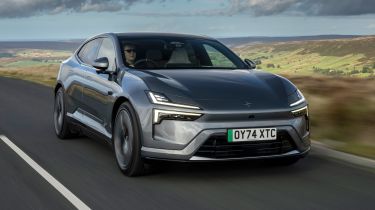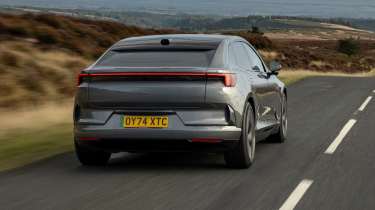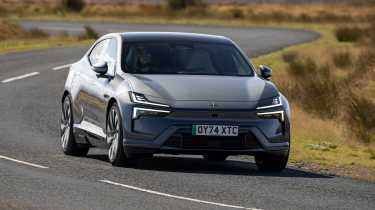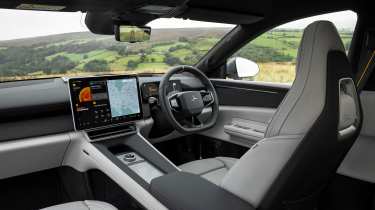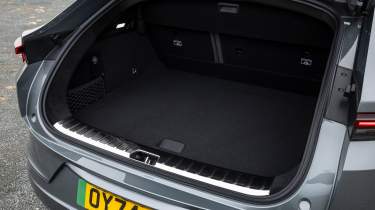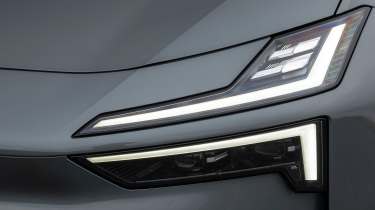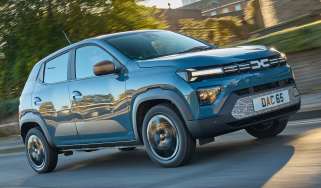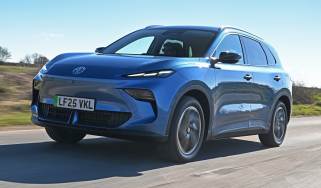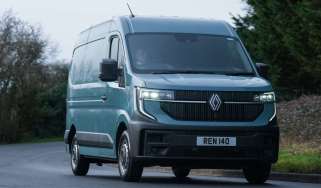Polestar 4 review
The Polestar 4 is a premium mid-size SUV that's well known for not having a rear window. But there's far more to the car than that
Pros
- Plenty of performance
- Efficient and offers a long range
- Quality is high and interior very spacious
Cons
- Not exciting to drive
- Expensive to buy compared to rivals
- Technology won’t be to everyone's liking
| Range | Wallbox charge time | Rapid charge time |
| 367-385 miles | 11 hours (0-100%, 11kW) | 30mins (10-80%, 200kW) |
Polestar 4 verdict
The Polestar 4 is a characterful and premium option in a tightly fought electric SUV sector. Its long range, which starts from 367 miles, gives it an edge over rivals, and Polestar’s decision to do without a rear window makes the 4 stand out without compromising anything in a meaningful way. The Polestar 4 offers the best technologies available, but the infotainment system might take some time to get used to, and this SUV is not the most engaging to drive in the class.
Details, specs and alternatives
The Polestar 4 is the fourth standalone car to come from the Swedish brand, hence its name. But, in actual fact, it sits between the Polestar 2 hatchback and Polestar 3 SUV in the company’s range, and takes on other mid-size electric SUVs such as the Audi Q6 e-tron, Tesla Model Y and Porsche Macan Electric.
However, Polestar has brought its A-game with the 4, using the Sustainable Experience Architecture (SEA) also found underpinning other Geely group cars including the Volvo EX30 and Smart #3. This means the Polestar 4 can offer advanced technologies, a chunky 94kWh battery pack, and with the platform being closely linked to Volvo, cutting-edge safety systems. Polestar felt there was no need for the 4 to have a rear window, replacing it with a rear camera and digital rear-view-mirror.
Starting from around £60,000 for the Single motor variant and ranging up to just under £67,000 for the Dual motor model, the Polestar 4 can easily out-pace the competition when it comes to range. Single-motor, rear-wheel drive cars can travel up to 385 miles on a charge, while dual-motor, four-wheel drive cars can achieve up to 367 miles on a charge.
There’s plenty of performance on offer, too. Single-motor cars produce 268bhp and 343Nm of torque, while dual-motor cars can produce 536bhp or 686Nm of torque, although it should be said that the latter’s power output is a little down on the Porsche Macan Turbo Electric, for example.
There’s little in the way of customisation choices or optional extras to personalise your Polestar 4, partly because the car comes with lots of kit as standard, but also because Polestar neatly bundles extra equipment into packs. Only one paint colour – Magnesium silver – is a no-cost option, with the other shades costing either £1,000 or £1,400.
It’s worth explaining the optional packages, because many potential owners will select them when ordering. The Pilot Pack gives some additional safety features and costs £1,300, while the £1,800 Pro Pack adds larger 21-inch alloy wheels and gold-coloured seat belts. Finally, the Performance Pack brings 22-inch wheels, tweaks to the chassis to help improve driving responsiveness, and Brembo brakes for better stopping power – it costs £4,000.
Range, battery size & charging
| Model | Range | Wallbox charge time | Rapid charge |
| Polestar 4 Long range Single motor | 385 miles | 11 hours (0-100%, 11kW) | 30mins (10-80%, 200kW) |
| Polestar 4 Long range Dual motor | 367 miles | 14 hours (0-100%, 11kW) | 30mins (10-80%, 200kW) |
There’s only one battery size available with the Polestar 4, and it’s quite sizable at 94kWh. That means the Long range Single motor variant of the car can manage up to a claimed 385 miles on a charge, while the more powerful Long range Dual motor car can travel up to 367 miles. By comparison, Porsche says the Macan Turbo Electric can also cover 367 miles, while the Audi SQ6 e-tron can only manage 358 miles on a charge.
When we drove the Polestar 4, we saw a real-world range of 369 miles for the Long range Single motor car, and 342 miles for the Long range Dual motor. This high real-world range is in part down to the car's smooth surfaces, flush-fitting door handles, aerodynamic wheels and the shallow rake of the windscreen, which contribute to the wind-cheating shape of the car.
Official efficiency figures claim single-motor cars can return 3.4 miles per kWh, while dual-motor cars offer 2.8kWh. This has the potential to be improved over time, because the Polestar 4 should receive at least four over-the-air updates throughout the course of a year, boosting efficiency and range.
When it comes to topping up the battery, the 94kWh pack can charge at a maximum speed of 200kW, getting from 10 to 80 per cent in 30 minutes. This isn’t as quick as some of the 4’s rivals, but it’s not far behind. If you’re using a home wallbox charger, be prepared for a longer wait; 22kW AC charging is offered and a 0-100 per cent recharge will take roughly 5.5 hours, 11 hours when charging at 11kW, or around 14 hours from a 7.4kW unit.
Running costs & insurance
The premium SUV sector isn’t exactly known for its frugality or catering for bargain hunters, and the Polestar 4 isn’t an exception to this rule. With a starting price of around £60,000 for single-motor cars, ranging up to around £67,000 for dual-motor cars, the Polestar 4 isn’t exactly cheap.
As for insurance, the Long range Single motor edition sits in group 45, and the Long range Dual motor is in Group 48, meaning the 4 fits in the middle of both the Audi Q6 e-tron and Porsche Macan Electric.
Having previously been exempt from VED, or ‘road tax’, owners of EVs like the Polestar 4 have to fork out £195 per year from April 2025. Company car drivers, meanwhile, will pay 3 per cent in Benefit-in-Kind in 2025/26 and 4 per cent in 2026/27.
Running costs will be significantly less than for equivalent combustion-powered SUVs. Fully charging the Polestar 4 at home on a 7kWh wallbox will cost around £27 at the average electricity rate of 30p per kilowatt-hour. As always, using a public chargepoint will cost considerably more.
Performance, motor & drive
| Model | 0-62mph | Top speed | Driven wheels | Power |
| Polestar 4 Long range Single motor | 7.1 secs | 124mph | Rear | 268bhp |
| Polestar 4 Long range Dual motor | 3.7 secs | 124mph | All | 536bhp |
Before Polestar became a brand in its own right, it was the performance division of Volvo. However, it would be best to forget this sporty heritage, because the Polestar 4’s portly 2,232–2,351kg kerbweight and general bulkiness can be felt if you’re travelling down a twisty road.
Whichever version of the Polestar 4 you opt for, though, it’s not exactly short on power. The Long range Single motor car produces 268bhp and 343Nm of torque, which will be more than enough for most people, and the power delivery is linear and smooth. For those who want a little extra pep, there’s the Long range Dual motor variant, which can easily rival some supercars with a total output of 536bhp and 686Nm of torque.
Both versions are responsive in a straight line, but when the road gets twisty, you’re reminded that Polestar 4 is an SUV and not a sports car. At least, the car manages to hide its weight most of the time, though, with the suspension able to cope with potholes and rutted roads, and it never feels like it’s short of grip.
In the dual-motor car, it is possible to alter the dampers between ‘Standard’, ‘Nimble’ and ‘Firm’. Standard is comfortable for everyday driving, while Nimble and Firm offer more in the way of sporty driving dynamics – although there’s not too much difference between the two in our opinion. Most of the time you’ll probably keep it in Standard, which manages to take the sting out of sharp bumps in the road.
The steering feel can be altered between ‘Light’, ‘Standard’ and ‘Firm’, and there’s a good variation between the settings. However, the steering can be a little vague overall and the front end can take a while to respond, while rough or jerky steering inputs can upset the car’s balance.
Drive sensibly, and the Polestar 4 turns into a comfortable and capable machine in any situation. At higher speeds, it’s quiet and composed, with very little in the way of intrusion from road and wind noise, and no audible difference between single and dual-motor cars. The side mirrors do cause some buffeting, although this is one of our only complaints on the road.
Low speeds can catch the Polestar 4 out, with the ride seeming fidgety and unsettled. The single-motor car we were driving had the larger 21-inch alloys fitted, which probably didn’t help overall ride quality, so cars with smaller alloys may fare better.
When it comes to slowing down, the brakes are responsive without feeling overly grabby, and you’re able to recoup some of the lost energy through regenerative braking. There are three levels of brake regeneration, including ‘Off’, ‘Low’ and ‘One-pedal’. One-pedal driving has the ability to bring the car to a stop and is great in urban environments. From our experience, the ‘Low’ setting seems to offer the best balance and has a similar feel to engine-braking in an internal combustion-engine car.
Interior, dashboard & infotainment
The premium electric SUV sector is now one of the most hotly contested in the market, so it’s only right that Polestar has used high-quality materials, with a good standard of fit and finish throughout.
As with the Polestar 2 and 3, the dashboard follows a minimalist design. Instead of using buttons and switches, the majority of the Polestar 4’s functions are operated through the 15.4-inch touchscreen, which uses Google-based software. Overall, the system is fairly straightforward to use, the design is simple to understand and there are shortcuts on the home screen to simplify the operation. Our car wasn’t the quickest to respond to inputs, but we’re told that customer cars are faster.
The lack of a rear window might be off-putting to some, however; Polestar has fitted an 8.9-inch digital rear-view mirror, which is of a high-resolution and offers a crisp display. The system works well at night and in low light and it can also be used as a conventional mirror to look at rear seat occupants, if needed.
In front of the driver, there’s a 10.2-inch digital display that has all the information you need. It is easily customisable and the head-up display is simple to read with clear graphics.
Boot space, seating & practicality
| Length | Width | Height | Boot space |
| 4,840mm | 2,139mm | 1,534mm | 526 litres |
You might think the Polestar 4 would not be hugely practical thanks to its sloping roofline, but it’s actually a spacious car.
Up front, the driving position is spot on and it's really easy to get comfy behind the wheel, with the seats offering the right blend of support and comfort. As standard, the front seats are heated and electrically operated, but if you spec the Nappa leather pack, you��ll get perforated Bridge of Weir leather upholstery, as well as a massage function.
Neither the front nor the rear of the cabin feels cramped, and the sloping roofline doesn’t eat into the headspace of rear passengers. You might expect the rear of the cabin to feel dark with the lack of a rear window and low-slung roof, but this isn’t the case thanks to the large side windows and the panoramic glass roof fitted as standard.
In-cabin storage is plentiful with cubby holes dotted around and a large 15-litre compartment within the centre console. There are also cup-holders in the rear armrest.
The boot capacity of the Polestar 4 is 526 litres, and there is an additional 31 litres below the removable boot floor. This is generous when compared with the larger Polestar 3, but the Polestar 4 does fall a little short when compared to rivals like the Porsche Macan Electric with its 540-litre boot capacity, or the 854 litres offered by the Tesla Model Y. The boot lip is a little high too, and the sloping roofline means loading bulky items could be a bit difficult and awkward.
If you need to tow a trailer or caravan, the Polestar 4 is rated to haul a maximum of 1,500kg in its single-motor guise, or up to 2,000kg in the dual-motor car.
Reliability & safety rating
The Polestar 4 hasn’t faced Euro NCAP safety tests yet, but because Polestar has close links to Volvo, driver and passenger safety is usually high on the agenda.
Overall there are 12 exterior sensors, 11 cameras and a front radar providing vital information to safety systems including adaptive cruise control, lane-keep assist, collision avoidance, blind-spot monitoring and post-impact braking. All these systems come as standard on the Polestar 4, as well as seven airbags and an interior radar system to help prevent animals or children being left behind in the car accidentally.
Polestar owners are pretty impressed with their cars, and the brand achieved second place in the Driver Power survey in the manufacturers category. But when it comes to reliability, Polestar’s reputation is already a bit patchy. Overall, 69 per cent of Polestar 2 drivers have had a fault of some kind within the first year of ownership. It must be noted that until recently, the Polestar 2 was the only car offered by the manufacturer – we’ll understand more when owners of the Polestar 3 and Polestar 4 get the chance to report back.
The Polestar 4 comes with a three-year/60,000-mile warranty. The battery pack has a separate warranty of eight years or 100,000 miles, whichever comes first. If the overall battery’s state of health dips below 70 per cent within the first eight years, Polestar will replace it at no cost.
Service and maintenance are covered for the first three years or 31,250 miles, whichever comes first. After the first three years, we’d expect the Polestar 4 to follow a similar service schedule to the Polestar 2 – so every two years or 20,000 miles.
